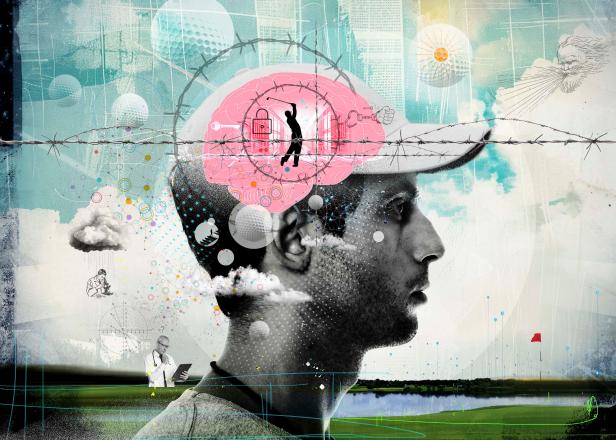We can learn to think like the best players in the world, but as sports psychologist Dr. Bhrett McCabe explains, there are numerous landmines, or mental mistakes, that we commonly make on the course that cause our scores to suffer. McCabe joined us for the Golf Digest Happy Hour, our live webinar series with golf experts, offered exclusively for Golf Digest+ members. This Q&A, selected from the one-hour interview, has been edited for clarity and concision.
Many of us get frustrated when we can’t take our range game to the course. How do we fix that?
McCabe: One of the biggest concepts I teach is called capability and capacity. We are all capable of something. Scottie Scheffler and players on tour have high capabilities, but when they go play, they’re not going to have 100 percent of their toolset. They may be tired, or they may have a group they don’t like or they may be hitting it so good that their yardages are plus three yards and it’s disconcerting.
If you could put your finger on a scanner and it said, “OK, you’ve got 78 percent of your abilities today,” most people would say, “Oh, man, I hope I have my driver.” Most players are trying to find the 22 percent that is missing.
As a result, they’re out there messing with their swing and trying to find a groove. The best players are focusing on the 78 percent that they have, so they make adjustments like downshifting to a fairway finder off the tee.
McCabe: There was an article written 15 years ago by some University of Pennsylvania Wharton business school professors. The title of the article was, “Is Tiger Woods Loss Averse?” They found that Woods made more par putts than he did birdie putts from the same distance after controlling for all factors.
A few years later, I challenged a statistician to figure out why that was. He found that players tend to miss birdie putts short. It’s natural for the mind, as you’re walking up to a 12-footer for birdie, to think, I’d like to make birdie, but what I don’t want is to have a three-putt.
When you’ve got a par putt, what are you thinking? I’m making this son of a gun or nothing. You tend to lock in, and you reduce the amount of choices that are available on your decision. Now, if you could look at a birdie putt the same way you look at a par putt, then you’ve cracked the code, but we can’t. Is a three-putt worth the risk to make a birdie? That’s a hard decision to make.
McCabe: What are you feeling on the first tee? I need to get off to a good start. I’ve got to get it all. I don’t try to suppress those emotions. Let them come in. We experience them, and then we just let them pass. Identify what you are trying to do, and turn to your go-to fairway-finder shot. Pick a clear target. Accept how you feel, and verbalize the shot you want to hit. I don’t want you to feel calm. I want you to feel connected to your process.
(Editor’s Note: This story is part of the new Golf Digest Community section, where we engage with Golf Digest+ members. We encourage all members to submit swing videos, great stories, questions or feedback on recent stories here for a chance to be included in a future edition.)
